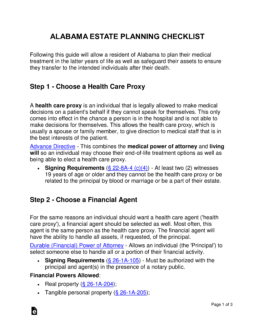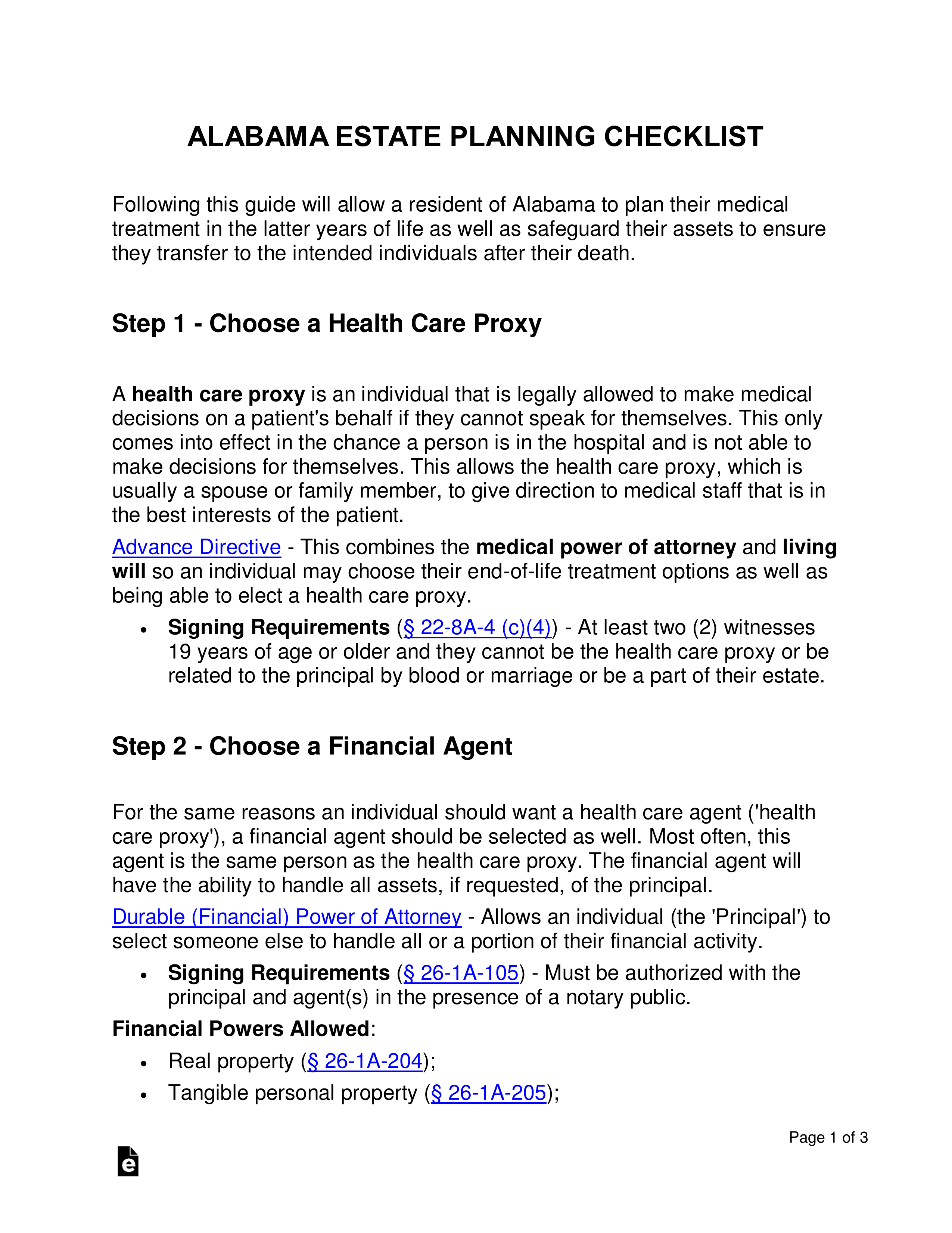Updated April 16, 2024
An Alabama estate planning checklist is a list of documents that assist an individual who is arranging their estate and end-of-life medical requests. To care for oneself, their treatment options and a health care proxy can be selected in an Advance Directive. For assets and property, a “financial agent” should be selected in a Durable Power of Attorney and choose from either a Will or Living Trust to pass on the estate.
How to Create an Estate Plan in Alabama (6 steps)
- Choose a Health Care Proxy
- Choose a Financial Agent
- Make a List of All Assets and Real Estate
- Decide ‘Who Gets What’
- Write a Living Trust or Last Will and Testament
- Storing the Documents
Following this guide will allow a resident of Alabama to plan their medical treatment in the latter years of life as well as safeguard their assets to ensure they transfer to the intended individuals after their death.
1. Choose a Health Care Proxy
A health care proxy is an individual that is legally allowed to make medical decisions on a patient’s behalf if they cannot speak for themselves. This only comes into effect in the chance a person is in the hospital and is not able to make decisions for themselves. This allows the health care proxy, which is usually a spouse or family member, to give direction to medical staff that is in the best interests of the patient.
Advance Directive – This combines the medical power of attorney and living will so an individual may choose their end-of-life treatment options as well as being able to elect a health care proxy.
- Signing Requirements – At least two (2) witnesses 19 years of age or older and they cannot be the health care proxy or be related to the principal by blood or marriage or be a part of their estate.[1]
2. Choose a Financial Agent
For the same reasons an individual should want a health care agent (‘health care proxy’), a financial agent should be selected as well. Most often, this agent is the same person as the health care proxy. The financial agent will have the ability to handle all assets, if requested, of the principal.
Durable (Financial) Power of Attorney – Allows an individual (the ‘Principal’) to select someone else to handle all or a portion of their financial activity.
- Signing Requirements – Must be authorized with the principal and agent(s) in the presence of a notary public.[2]
Financial Powers Allowed:
- Real property[3]
- Tangible personal property[4]
- Stocks and Bonds[5]
- Commodities and Options[6]
- Banks and Other Financial Institutions[7]
- Operation of Entity or Business[8]
- Insurance and Annuities[9]
- Estates, Trusts, and other Beneficial Interests[10]
- Claims and Litigation[11]
- Personal and Family Maintenance[12]
- Benefits from Governmental Programs or Civil or Military Service[13]
- Retirement Plans[14]
- Taxes[15]
- Gifts[16]
3. Make a List of All Assets and Real Estate
4. Decide ‘Who Gets What’
5. Write a Living Trust or Last Will and Testament
Depending on the preference of the individual, a document will need to be created that allows the transfer assets and property in the estate to the beneficiaries. The following options are available:
Last Will and Testament (‘Will’) – The most traditional way to transfer an estate after death. The estate will still have to go through the probate process which usually takes 6-8 months if no one contests.
- Signing Requirements – Required to be signed in the presence of two (2) witnesses.[17]
Living Trust (Revocable) – Creates an entity with the creator being the trustee and the beneficiaries being the successor trustees. Therefore, the creator benefits from the assets in the trust until their death. Afterward, the successor trustees become the owners of the trust.
- Signing Requirements – No witnesses required by State law. Although, it’s recommended the creator (the ‘Grantor’) authorize the attached Self-Proving Affidavit which acknowledges the signature in front of either two (2) witnesses and a notary public.[18]
Main Difference – A Last Will and Testament must undergo the probate process while a Living Trust does not.
6. Storing the Documents
In the case of medical and durable power of attorney, original copies should be given to the agent(s) selected. For estate forms, the creator’s attorney should receive a copy along with the beneficiaries. This will ensure that an heir or family member will have a copy at the time of death.It is recommended to have the completed documents reviewed by a licensed estate attorney in Alabama.
Alabama Estate Planning Laws
- Advance Directive – § 22-8A-4
- Durable Power of Attorney – § 26-1A-301
- Last Will and Testament – § 43-8-1(34)
- Living Trust (Revocable) – § 19-3B-602


